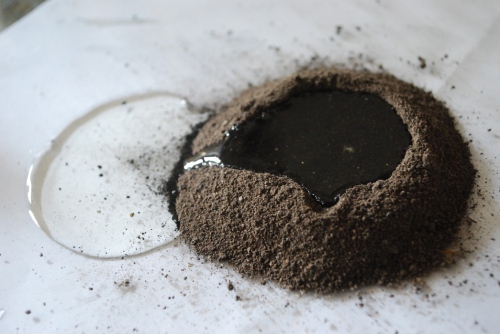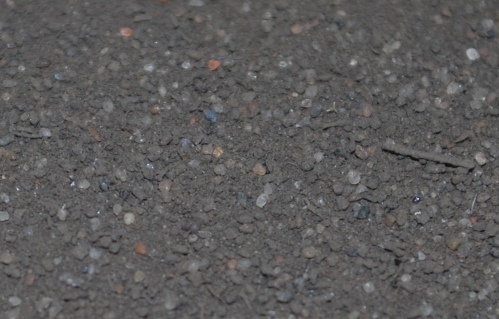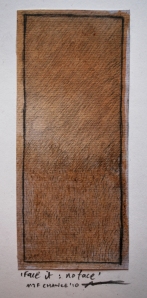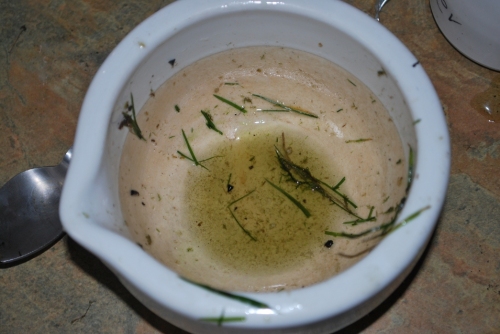I started thinking about making inks when I planned to apply to that Green and Away residence, because my project had to use materials from the fields and woods around the site. I planned to develop print making processes that were entirely based in the natural environment, so scratching into rocks or making woodcuts, that kinda thing, but also needed to work out how to make my own inks and paints in the same way.
Having done minimal amounts of research, I noticed that ink is basically just a pigment (coloured powder) mixed with oil. Ink can then be thickened using wax I believe. Making a pigment is fairly easy, so I started this with some soil from the garden.
Spreading the soil onto a tray, I grilled it for a while to try and remove as much moisture as I could.
I then ground some of this in a pestle and mortar, and heaped it onto a pane of glass to be mixed with a bit of vegetable oil.
Unfortunately this makes quite a gritty paste rather than a smooth ink, as you can see:
This means that the particles of soil are too big to mix properly with the oil, so that if painted on a page the oil stains the page while most of the soil separates into clumps:
the problem is not necessarily the method but the materials. The soil is much too sandy and granular, so that even after I’d put it through a seive, you could still see lots of tiny lumps of glass and rock within it if you looked very closely:
I tried mixing some spreadable butter into it, making a fairly smooth paste that could be rolled and used for simple monoprints:
Next I tried making some water based paint using some old onion skins. These were boiled in a small amount of water for 20 mins
After being boiled, they’d taken on a rich red colour, and the reduced water looked pretty awesome.
Unfortunately it doesn’t work quite like that on the page, but it still makes some nice yellow/sepia-ish washes like zis.
The darker patches on this picture also have some paprika and butter paint layered over the onion skin wash, tasty.
Next I tried grass, deciding to grind some fresh leaves with some vegetable oil.
The grass can then be clumped together and used to apply the grass oil onto the paper:
I was pretty pleased with this one
Some, like this one, had thick soil paint spread on the back and drawn into, which shows through the oily translucent paper:
Next I ordered a bottle of cold-pressed linseed oil, which is the best kind to mix oil paints. I burned a few old envelopes to get a pile of ash, which was then ground in the pestle and mortar to form a fine, smooth grey pigment.
When mixed with the linseed oil it makes a really good syrupy paint
which can be painted on with ease. This one’s backlit by the way:
I’ve also used the ash paint for a bit of life painting with drawing over the top. The paint works really well, you can loosen it with more oil or turpentine and it dries with a really nice charcoal finish that works well with the added pencil patternation.
Currently listening to: Jah Wobble & The Chinese Dub Orchestra – Chinese Dub




















this is awesome! can you tell more about different colors you have been able to get?
i’m interested in ink, actually, because i do calligraphy.
thanks! At the moment I haven’t experimented much more beyond the colour range you can see in this series of pictures (take a look at the post called Celebrating Mystery) as I’ve been quite busy, but when I get a chance I’m going to get hold of some more ingredients. I would love to work out how to make a nice blue pigment, without resorting to buying in mineral or rock dust.
calligraphy’s brilliant, I like the looser eastern brush traditions a lot.
Just boiled up some ink cap toadstools to see what kind of ink they make. Some of the instructions for oak gall ink say add witch hazel, I’ll try adding some to some of the black gunge I’ve made! I love those landscape images you’ve created. Good luck with blue, have you tried red cabbage?
Hi there Mr. Chance!
How do you make vegetable ink? Do you put it into a blender or what? I’ve attempted to make it but it wouldn’t work because there were some small long strips of what was leftover of the vegetable instead of the powder…so I’m basically stumped…. Help please?
Ley, that sounds brilliant, I’d like to see how you got on. I haven’t tried red cabbage but it looks great, check out this recipe here: http://www.sundayschoolpages.com/craftsrecipes/craft-recipes/painting-with-red-cabbage-paint/
Deemas, I haven’t tried it but I think if you wanted to use vegetable matter you would be better chopping it very finely with a sharp knife then grinding it with linseed oil in a pestle and mortar. It’s hard to extract much colour from vegetables, I’d like to try a drying and grinding method sometime.
Oh, so that’s where I went wrong, thanks Mr. Chance.
Do you by any chance have a coffee grinder and/or a dehydrater?
If yes, then this method sounds good; http://www.wikihow.com/Make-Vegetable-Powders
I’ve read other related articles which includes dehydrating the vegetables by using an oven however it seems a bit time more consuming and pricey. What about frying the vegetables?
I’m not sure about frying… need to do some food science research I think. It would definitely be a bad method of drying seeing as they’ll just char on a dry pan and anyway I’m not sure that cooking it will help extract any colour.
I know you can make water based dyes with raw vegetables like beetroot and red cabbage if you grate them, squeeze them with some warm water in a plastic bag with a hole in the corner and drain out the juice. I guess repeating this process over and over would result in a fairly strong colour, which you could then try and reduce further on a gentle heat.
I haven’t got a dehydrator, no, but I think it would be well worth trying an oven drying method. If not you can string up some fruits/vegetables and leave them to dehydrate in a warm dry place.
can you tell us how to make inks using common plants?
This is cool…and helpful. I have a kachina made from cottonwood that is very faintly painted….my sense is that it has been painted with natural pigment. I would like to enhance its coloring without offending its Spirit with plastics.
If you have suggestions, I would be most grateful. The colors needed are yellow, ochre, deep blue and red.
Warm regards and wishing you a Happy Thanksgiving!
just char your veg like eggplant until all black; blend smooth; spread on a sheet pan and dehydrate in oven; blend again with oil to make ink
Still haven’t done anything with my inks, the first lot went mouldy, I now have some oak galls waiting to be powdered, I’m going to try them on their own and also adding them to the ink cap toadstool gunge. Apparently ai have the wrong kind of toadstool it should be shaggy ink cap for really good ink. I won’t get any more toadstools for a while as they grow when it’s wet, mind you here in Devon that’s most of the time!
Woops I hit the a instead of the shift, I’m not trying to sound posh should say I not ai obviously
did you know, how made an ink from a rock?
thx
finally got round to making the oak gall ink, soaking the crushed galls until tomorrow,they need iron adding, apparently you can just throw wire wool into the liquor once ou’ve strained it and then add Gum Arabic, or egg white for a fairly short shelf life. Got that instructyion from an “Instrucibles” page forgot to make a note of the link sorry. Working on a Big Draw event so the inks will get used in October.http://www.thebigdraw.org
fabulous
Still working on those inks, the oak gall ink looks nice and black, bought some Gum Arabic to add to it, I also have a dish of rust on the go, remember using this in the 70s when I was doing a textile design course, I also have a jar of beetroot liquor, I roasted some beetroots and have sokaed the skins and leaves in boiing water, the slight problem is the oil I roasted them in, I have managed to skim most of it off now it’s settled. The Big Draw event takes place on the 29th so I’ll let you know what happens. I’ve got some feathers ready to cut into pens and a bamboo and plant stem pen cut. should be fun I hope.
Hello! This is a lovely post! I’m currently in the process of making body paints from found material pigments. Attempting to make the basic colors red, blue, yellow, and black. It’s turned out to be so much more complicated than I initially assumed. I’ve run into a big roadblock with blue, especially, as it is quite hard to find blue pigments in nature. I’ve recently had a breakthrough with red cabbage, however I can’t get it to mix with oils to make a paint because of the particular properties of that plant. I’ve only gotten the blue to come out with water. Do you have any suggestions or information that might help? It would be insanely appreciated.
Have you tried an emulsifier, powdered mustard for example? Not sure of the reason for non mixing with oils. Most well known natural blues are woad and indigo, not sure where you’d get woad these days and indigo is crazy expensive. Good luck.
Pingback: Natural Ink recipes – unit seven
Pingback: Project Proposal: Draft 4 – unit seven